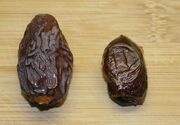
Two fruits of the Date Palm, The Left is a Medjool date, the right is a Khadrawi (or Hadrawi) date.
The Date Palm fruit is known as a date. Only female trees produce dates. The fruit's English name (through Old French), as well as the Latin species name dactylifera, both come from the Greek word for "finger", dáktulos, because of the fruit's elongated shape.
Dates are oval-cylindrical, 3–7 cm long, and 2–3 cm in diameter, and when ripe, range from bright red to bright yellow in colour, depending on variety. Dates contain a single stone about 2–2.5 cm long and 6–8 mm thick. Three main groups of date exist: soft (e.g. 'Barhee', 'Halawy', 'Khadrawy', 'Medjool'), semi-dry (e.g. 'Dayri', 'Deglet Noor', 'Zahdi'), and dry (e.g. 'Thoory'). The type of fruit depends on the glucose, fructose and sucrose content.
Dates ripen in four stages, which are known throughout the world by their Arabic names kimri (unripe), khlal (full-size, crunchy), rutab (ripe, soft), tamr (ripe, sun-dried).
Dates are an important traditional crop in Iraq, Arabia, and north Africa west to Morocco. In Islamic culture, dates and yogurt or milk are traditionally the first foods consumed after the sun has set during Ramadan.